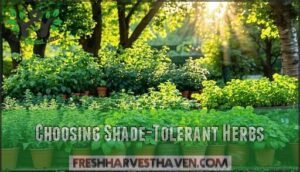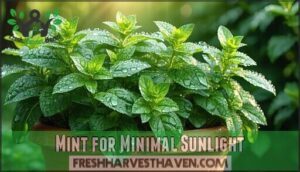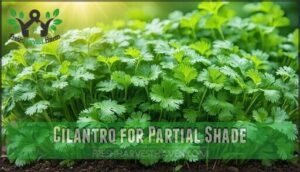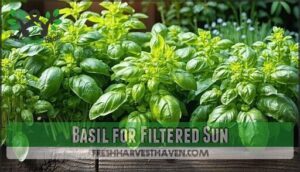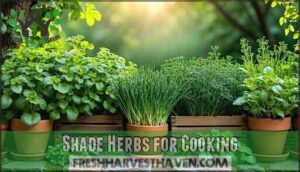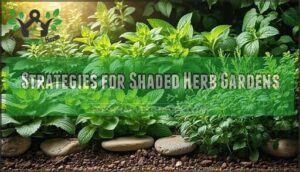This site is supported by our readers. We may earn a commission, at no cost to you, if you purchase through links.

Focus on leaf herbs rather than seed producers, and make sure your soil drains well—think wrung-out sponge, not swamp. Sweet woodruff and shiso add unique flavors to your collection. The secret lies in matching each herb’s specific needs to your garden’s conditions.
Table Of Contents
- Key Takeaways
- Growing Herbs in Shade
- Herbs for Shaded Gardens
- Shade Herbs for Cooking
- Strategies for Shaded Herb Gardens
- Unique Shade-Tolerant Herbs
- Frequently Asked Questions (FAQs)
- Which herbs are shade tolerant?
- What plants grow well in shade?
- Can herbs grow in shade?
- Which herbs can be used in shady conditions?
- Do herbs need sun or shade?
- Does parsley grow in shade?
- What is the most shade tolerant herb?
- What will grow in full shade?
- Can rosemary grow in shade?
- Can basil grow in the shade?
- Conclusion
Key Takeaways
- You don’t need full sun to grow flavorful herbs – mint, parsley, cilantro, and lemon balm actually thrive with just 2-4 hours of daily sunlight and prefer cooler, shaded conditions over harsh afternoon heat.
- Focus on leaf herbs rather than seed-producing varieties when selecting for shade gardens, as these plants naturally adapt better to low-light conditions and produce more tender foliage.
- You’ll need well-draining soil that feels like a wrung-out sponge, not waterlogged – shade herbs are more prone to root rot, so proper drainage becomes even more critical than in sunny gardens.
- Consider unique shade-tolerant options like sweet woodruff and shiso to add distinctive flavors and fragrances to your collection that you won’t find at the grocery store.
Growing Herbs in Shade
You don’t need full sun to grow flavorful herbs in your garden. Many herbs actually prefer partial shade and will produce better leaves when they’re protected from intense afternoon heat.
Choosing Shade-Tolerant Herbs
Your herb garden’s success starts with smart variety selection. Focus on shade tolerant herbs harvested for leaves rather than flowers or seeds. These herb varieties naturally prefer partial shade and cooler conditions, producing better foliage without scorching sun.
Consider each plant’s specific light requirements, soil preferences, and growth habits when planning your garden design. **Mint, parsley, and cilantro excel in growing herbs in shade situations.
** Match your shade tolerant herbs list to your garden’s unique conditions for thriving results.
Understanding Sunlight Requirements
Understanding your garden’s sunlight needs starts with measuring light intensity and sun duration. Full sunlight means 6+ hours daily, while partial shade offers 3-6 hours of gentler morning exposure. Shade tolerant herbs need a minimum of 2-4 hours for healthy photosynthesis rates.
Spectral quality matters too—morning light proves less intense than afternoon rays. Ideal exposure depends on each herb’s specific requirements for growth.
A garden journal can help track sunlight levels over time for perfect planting.
Soil Conditions for Shaded Herbs
Successful shade tolerant herbs depend on proper soil conditions for herbs. You’ll need rich soil with excellent drainage – waterlogged roots spell disaster. Target soil pH levels around 6.0-6.5 for ideal nutrient availability.
Mix organic amendments like compost into your shade garden beds. This creates the perfect balance of moisture retention without soggy conditions. Your moist soil should feel like a wrung-out sponge, not a swamp.
**These adjustments help herbs thrive despite limited sunlight.
Herbs for Shaded Gardens
You don’t need perfect sun to grow outstanding herbs in your garden.
These shade-loving varieties thrive with just a few hours of morning light and actually prefer cooler, moister conditions than their sun-worshipping cousins.
Mint for Minimal Sunlight
Mint thrives in shade with just 2-4 hours of filtered light daily. Mint varieties like spearmint and peppermint flourish in low-light conditions.
These shade tolerant herbs spread aggressively, making container mint your best bet for growing herbs in shade. Mint propagation happens quickly through runners.
Their culinary uses shine in teas and cocktails, perfect for shade gardening success.
Cilantro for Partial Shade
Cilantro excels in partial shade, especially when temperatures climb. This shade tolerant herb prevents bolting by staying cool in your herb garden.
Here’s why cilantro loves growing herbs in shade:
- Bolting prevention keeps leaves tender longer
- Ideal moisture retention enhances flavor intensity
- Harvesting techniques improve with steady growth
Use companion planting with parsley or chives for best results.
Lemon Balm for Attracting Pollinators
Lemon balm thrives in your shade tolerant herbs collection, needing just 4-6 hours of dappled light. Its excellent shade tolerance makes growing herbs simple in darker garden spots.
This pollinator magnet draws bees and butterflies with its citrusy fragrance. Different balm varieties offer unique scents for companion planting.
You’ll enjoy lemon balm benefits like natural pest control and aromatic leaves.
Basil for Filtered Sun
While lemon balm draws beneficial insects, basil varieties like Thai and lemon basil excel in filtered sunlight conditions. These shade tolerant herbs prefer partial shade over blazing sun.
Check soil moisture regularly—keep it consistently moist but never waterlogged. Companion planting with chives boosts growth naturally.
When growing herbs in shade, proper harvesting tips matter: pinch flowers to maintain leaf production and encourage bushier plants.
Shade Herbs for Cooking
You’ll find plenty of culinary herbs that actually prefer shady spots, making your kitchen garden possible even without full sun.
These shade-loving herbs like parsley, dill, chives, and sorrel give you fresh flavors while thriving in cooler, low-light conditions that would stress sun-loving herbs.
Parsley for Low-Light Conditions
Among shade-tolerant herbs, parsley stands out as a reliable performer. This adaptable herb adapts well to growing herbs in shade with just 3-6 hours of daily sunlight. Here’s your complete guide:
- Parsley Varieties: Choose flat-leaf for cooking or curly varieties for garnish
- Light Requirements: Thrives in partial shade with morning sun preferred
- Soil Preferences: Rich, well-draining soil with consistent moisture
- Watering Needs: Keep soil evenly moist but never waterlogged
- Harvesting Tips: Cut outer stems regularly to encourage fresh growth
Parsley’s shade tolerance makes it perfect for your shade-tolerant herbs list, delivering fresh flavor year-round.
Dill for Cool Shady Areas
Dill varieties flourish in cool, shady spots that receive 4-5 hours of morning sunlight. This shade-tolerant herb prevents bolting when grown in partial shade, maintaining its delicate flavor intensity.
Shady dill care involves well-draining soil and regular watering. Companion planting with lettuce maximizes garden space while supporting bolting prevention.
| Growing Aspect | Shade Benefits |
|---|---|
| Temperature | Cooler conditions prevent stress |
| Bolting | Less likely in filtered light |
| Flavor | Leaves stay tender longer |
Chives for Edible Flowers
While dill thrives in cool spots, chives offer something special for your shaded herb garden. These hardy herbs produce beautiful purple flowers that pack surprising chive blossom flavor—mild onion notes perfect for culinary use. Growing edible chives couldn’t be easier in partial shade.
Try making chive flower vinegar for salads, or use blooms as colorful garnishes. Companion planting chives near tomatoes helps deter pests naturally. They also thrive in moist conditions, enhancing flavor pairings.
Sorrel for Tart Flavor
When choosing shade tolerant herbs for your garden, sorrel varieties offer exceptional tartness levels that transform ordinary dishes. Garden sorrel thrives in partial shade with continuous moisture, while French sorrel copes with drier conditions.
Growing sorrel provides culinary use through spring and fall harvests. These growing herbs deliver sorrel benefits including vitamin C, making them essential additions to any shade herb collection.
Strategies for Shaded Herb Gardens
You’ll need smart strategies to make your shaded herb garden thrive since these spots require different care than sunny gardens.
Focus on improving soil quality, ensuring proper airflow, adjusting watering schedules, and pruning regularly to boost growth in low-light conditions.
Enriching Soil for Reduced Sunlight
Something’s working overtime in your shade garden – the soil needs to pull double duty. When growing in shade, your herbs can’t rely on abundant sunlight for energy production. That’s where rich soil becomes your secret weapon for creating a thriving shade garden.
Shade gardens force your soil to work overtime since herbs can’t depend on abundant sunlight for energy
Smart gardeners know that shade-tolerant herbs depend on excellent nutrient balance to compensate for limited light. Here’s your game plan:
- Mix in organic matter like compost or aged manure to boost soil fertility
- Install drainage solutions to prevent soggy roots in moisture-prone shaded areas
- Test pH levels to maintain the 6.0-7.0 range most herbs prefer
- Apply quality soil amendments such as leaf mold or worm castings for sustained nutrition
- Layer organic mulch to retain moisture while suppressing competing weeds
These soil amendments create the foundation your shade garden needs to flourish. Using specialized herb compost can further boost growth.
Maintaining Good Airflow
Well-prepared soil means nothing if your shade-tolerant herbs can’t breathe. Spacing plants properly prevents overcrowding that blocks airflow in your herb garden. Pruning techniques open dense foliage, letting fresh air reach every leaf.
This circulation helps with preventing mildew and reducing humidity that lingers in shade. One key aspect of herb garden maintenance is to amend soil annually with compost.
Container placement also matters—avoid tight corners where air stagnates. Good airflow keeps your herbs healthy when growing in shade.
Irrigation Schedules for Shade
Good airflow sets the foundation, but watering frequency makes the difference between thriving shade-tolerant herbs and soggy disasters. Growing herbs in shade means slower evaporation rates, so you’ll water less often than sunny gardens. Overwatering risks are higher in moist soil conditions since drainage moves slower. One key is to use well-draining soils to prevent waterlogged soil.
Check soil moisture by pressing your finger one inch deep – only water when it feels dry.
- Water 1-2 times weekly – most shade herbs need this frequency
- Morning irrigation prevents fungal issues – excess moisture evaporates before nightfall
- Seasonal adjustments matter – reduce watering during cool, humid periods when drainage slows further
Pruning for Healthier Growth
Proper watering sets the foundation, but pruning techniques reveal your herbs’ full potential. Strategic trimming promotes disease prevention through improved air circulation while triggering growth stimulation in shade-tolerant herbs.
| Pruning Method | Best Timing | Expected Result |
|---|---|---|
| Pinching tips | Weekly growth | Bushier plants |
| Deadheading flowers | After blooming | Extended harvest |
| Stem cutting | Monthly maintenance | Better airflow |
| Leaf harvesting | Morning hours | Fresh flavor peak |
| Branch thinning | Mid-season | Light penetration |
Regular harvesting creates stronger, healthier plants that produce more flavorful leaves throughout the growing season. Using the right tools, such as specialized garden shears, can guarantee clean cuts and prevent damage to your herbs.
Unique Shade-Tolerant Herbs
You’ll discover several unusual herbs that thrive in shade and add unique flavors to your garden. These lesser-known options, like sweet woodruff with its vanilla scent and shiso with its cinnamon notes, grow well with minimal sunlight while offering distinct tastes you won’t find at the grocery store.
Sweet Woodruff for Fragrance
Sweet woodruff creates a fragrant groundcover that thrives in your shade garden. This aromatic herb releases vanilla-scented compounds when brushed against, making it perfect for pathways. Woodruff propagation happens naturally through spreading runners, creating dense mats under trees. Dappled light benefits shade garden plants.
Sweet woodruff offers multiple benefits:
- Companion planting – Deters garden pests effectively
- Culinary tradition – Flavors May wine and teas
- Medicinal benefits – Calms digestive discomfort naturally
- Aromatic uses – Freshens indoor arrangements when dried
- Shade gardening – Tolerates deep shade better than most herbs
Valerian for Tall Blooms
Valerian reaches towering heights of five feet, creating a stunning backdrop in your shade-tolerant herbs collection. This medicinal powerhouse thrives in partial shade with fragrant white blooms that attract beneficial insects.
Valerian propagation occurs naturally through self-seeding, though deadheading prevents aggressive spreading. Different valerian varieties offer varying heights for strategic companion plants placement in your herbs garden.
Golden Oregano for Decor
Golden oregano transforms your shade herb garden into a visual masterpiece with its vibrant chartreuse leaves. This ornamental variety thrives in partial shade while delivering impressive container gardening results.
Why golden oregano excels in your herb garden:
- Bright foliage creates stunning contrast against darker shade-tolerant herbs
- Compact growth habit makes it perfect for small container gardening spaces
- Light requirements are flexible – thrives in filtered sunlight conditions
- Culinary uses include mild oregano flavor for cooking applications
Consider companion planting with darker herbs to highlight its ornamental qualities.
Shiso for Cinnamon Aroma
Shiso adds spice to your shade herb garden with its rich Cinnamon Shiso Uses spanning teas to tempura. This Japanese herb tolerates partial shade beautifully. Growing Cinnamon Shiso provides unique flavors that complement Asian cuisine. Its Shiso Aroma Profile combines cinnamon, mint, and clove notes.
Frequently Asked Questions (FAQs)
Which herbs are shade tolerant?
Many herbs tolerate partial shade beautifully. You’ll find success with mint, parsley, cilantro, chives, lemon balm, and tarragon in spots receiving just three to six hours of sunlight.
What plants grow well in shade?
You’ll find plenty of options for shady spots in your garden. Popular choices include hostas, ferns, astilbe, and coral bells that thrive with minimal sunlight exposure.
Can herbs grow in shade?
Surprisingly, over 80% of herb gardeners think they can’t grow herbs without full sun. You can absolutely grow herbs in shade! Many varieties like mint, parsley, and lemon balm thrive in partial shade conditions with just 3-4 hours of daily sunlight.
Which herbs can be used in shady conditions?
You’ll discover several herbs that thrive with minimal sunlight: parsley, mint, chives, cilantro, oregano, thyme, and chamomile all adapt well to partial shade conditions.
Do herbs need sun or shade?
You’ll find most herbs thrive with 6+ hours of sunlight daily. However, leafy herbs like parsley, cilantro, and mint actually prefer partial shade, especially in hot climates.
Does parsley grow in shade?
Roughly 80% of herb gardeners struggle with shady spots, but parsley thrives there! You’ll get the best growth with 3-4 hours of morning sun.
It actually prefers partial shade during hot afternoons, preventing bitter leaves and early bolting.
What is the most shade tolerant herb?
Mint stands out as the most shade-tolerant herb you can grow. It’ll thrive in deep shade with just 2-3 hours of sunlight daily, spreading rapidly in moist, cool conditions.
What will grow in full shade?
Unfortunately, you can’t grow herbs in full shade—that’s complete darkness without any sunlight.
Even the most shade-loving herbs like chervil and sweet cicely need some light to survive and thrive.
Can rosemary grow in shade?
Rosemary doesn’t love shade. It can tolerate partial shade with 4-6 hours of sunlight, but it’ll grow slower and lose some fragrance. You’ll get better results with full sun.
Can basil grow in the shade?
Don’t put all your eggs in one basket – basil needs at least 6-8 hours of sunlight daily. It doesn’t thrive in true shade but can handle some afternoon protection from intense heat.
Conclusion
Ironically, the best herbs to grow in shade flourish where most gardeners think nothing will survive. You’ve discovered that mint, parsley, cilantro, and lemon balm don’t just tolerate shade—they prefer it.
These resilient plants reward your efforts with tender leaves and rich flavors. Start with these proven performers, guarantee good drainage, and you’ll soon wonder why you ever worried about that shady corner of your garden.
- https://celebratednest.com/herbs-for-shade/
- https://www.finegardening.com/article/beat-the-heat-with-shade-tolerant-herbs-and-veggies-in-the-southern-plains
- https://savvygardening.com/herbs-that-grow-in-shade/
- https://web.extension.illinois.edu/herbs/intro.cfm
- https://extension.umn.edu/planting-and-growing-guides/gardening-shade

